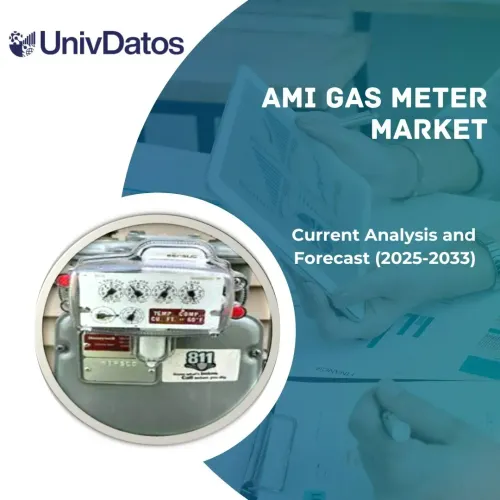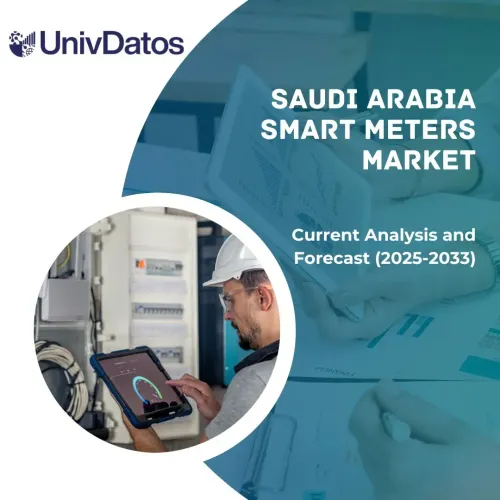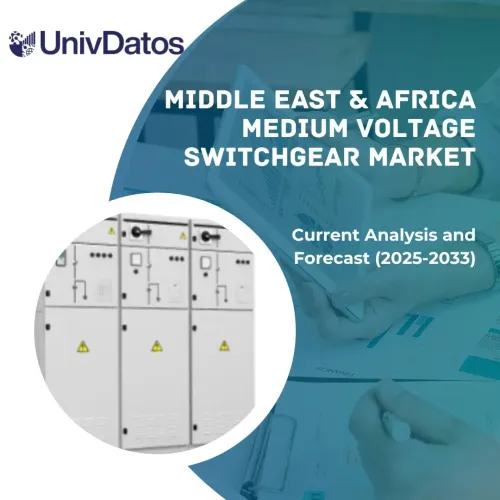- Startseite
- Über uns
- Industrie
- Dienstleistungen
- Lesen
- Kontaktieren Sie uns
Markt für intelligente Wasserzähler für Wohngebäude: Aktuelle Analyse und Prognose (2023-2030)
Schwerpunkt auf Technologie (Automatisierte Zählerfernauslesung (AMR), Intelligente Messsysteme (AMI)); Produkttyp (Warmwasserzähler, Kaltwasserzähler); und Region/Land
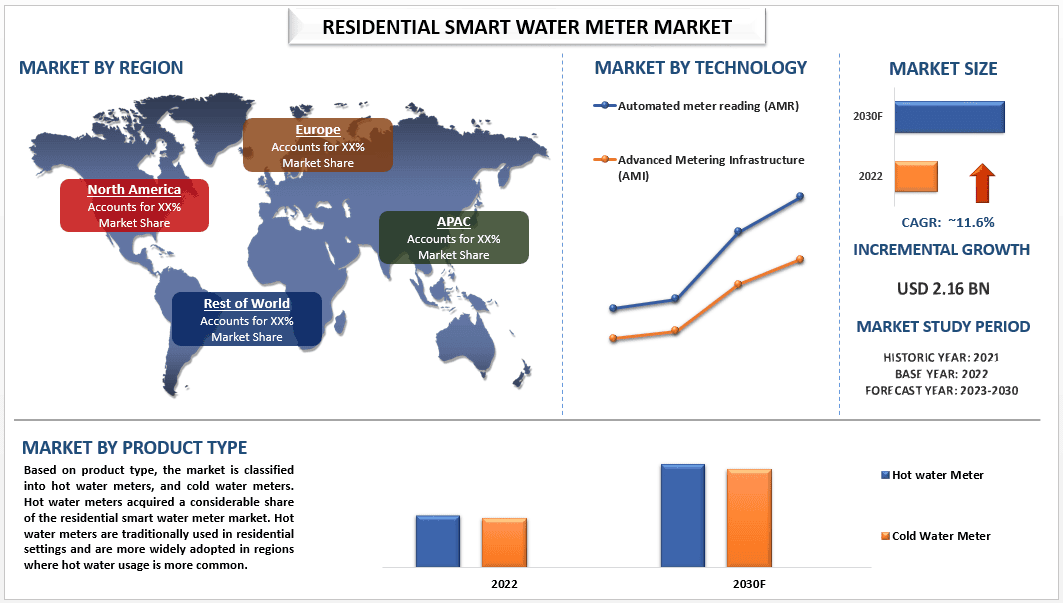
Es wird erwartet, dass der globale Markt für intelligente Wasserzähler im Wohnbereich im Prognosezeitraum mit einer beträchtlichen Rate von etwa 11,6 % wachsen wird. Der Markt für intelligente Wasserzähler im Wohnbereich wächst aufgrund von Faktoren wie der Tatsache, dass intelligente Wasserzähler Haushalten helfen, Wasser zu sparen, indem sie Echtzeit-Nutzungsdaten liefern, die es ihnen ermöglichen, Lecks oder andere Probleme zu erkennen und zu beheben. Dies kann zu erheblichen Wassereinsparungen führen, insbesondere in Regionen, in denen Wasser knapp oder teuer ist. Darüber hinaus können intelligente Wasserzähler die Genauigkeit der Abrechnung verbessern, indem sie automatisch Wasserverbrauchsdaten auslesen und an das Versorgungsunternehmen übertragen. Dies kann dazu beitragen, Fehler und Streitigkeiten zu reduzieren, und kann auch eine genauere Abrechnung auf der Grundlage des tatsächlichen Verbrauchs ermöglichen. Darüber hinaus beschleunigt die zunehmende Installation von intelligenten Wasserzählern im Wohnbereich in Entwicklungsländern die Marktnachfrage weiter. Zum Beispiel: Im Jahr 2021 verfügten die US-amerikanischen Elektrizitätsversorgungsunternehmen über etwa 111 Millionen installierte erweiterte (intelligente) Messinfrastrukturen (AMI), was etwa 69 % aller installierten Stromzähler entspricht.
Diehl Stiftung & Co. KG, Apator S.A., Badger Meter, Inc., Landis+Gyr, Honeywell International Inc., kamstrup, Itron Inc., Sensus, Arad Group, ZENNER International GmbH & Co. KG. sind einige der wichtigsten Akteure auf dem Markt. Mehrere Fusionen und Übernahmen sowie Partnerschaften wurden von diesen Akteuren eingegangen, um Kunden mit High-Tech- und innovativen Produkten/Technologien zu unterstützen.
Im Bericht vorgestellte Erkenntnisse
„Unter den Technologien wird die Kategorie der fortschrittlichen Messinfrastruktur im Prognosezeitraum eine höhere durchschnittliche jährliche Wachstumsrate (CAGR) verzeichnen.“
Basierend auf der Technologie ist der Markt in automatische Ablesemessgeräte und fortschrittliche Messinfrastruktur unterteilt. Das Segment der fortschrittlichen Messinfrastruktur verzeichnete im Jahr 2022 einen bedeutenden Marktanteil. Es wurden Lösungen für fortschrittliche Messinfrastrukturen (AMI) entwickelt, die darauf abzielen, die Defizite von AMR zu beheben, indem sie stattdessen eine feste Kommunikationsnetzwerkinfrastruktur nutzen. Durch die Ermöglichung hochfrequenter Messungen detaillierter Zählerdaten bei gleichzeitiger Ermöglichung der direkten Zwei-Wege-Kommunikation mit dem Utility-Backoffice eröffnen AMI-Lösungen den Wasserversorgungsunternehmen völlig neue Möglichkeiten, die betriebliche Effizienz erheblich zu steigern, den Non-Revenue Water (NRW) zu reduzieren und die Wassersparprogramme erheblich zu verbessern.
„Unter den Produkttypen wird das Segment der Warmwasserzähler im Jahr 2020 einen bedeutenden Anteil am Markt halten.“
Basierend auf dem Produkttyp wird der Markt in Warmwasserzähler und Kaltwasserzähler unterteilt. Warmwasserzähler erwarben einen beträchtlichen Anteil am Markt für intelligente Wasserzähler im Wohnbereich. Warmwasserzähler werden traditionell in Wohnhäusern verwendet und sind in Regionen, in denen die Warmwassernutzung häufiger ist, weiter verbreitet. Darüber hinaus sind Warmwasserzähler häufig in andere Smart-Home-Geräte wie Thermostate und Heizkessel integriert, was ihre Akzeptanz weiter erhöhen kann. Die Nachfrage nach Kaltwasserzählern wächst jedoch mit dem zunehmenden Bewusstsein für die Vorteile von Energieeffizienz und Einsparungen.
Berichtsabdeckung für den Markt für intelligente Wasserzähler im Wohnbereich
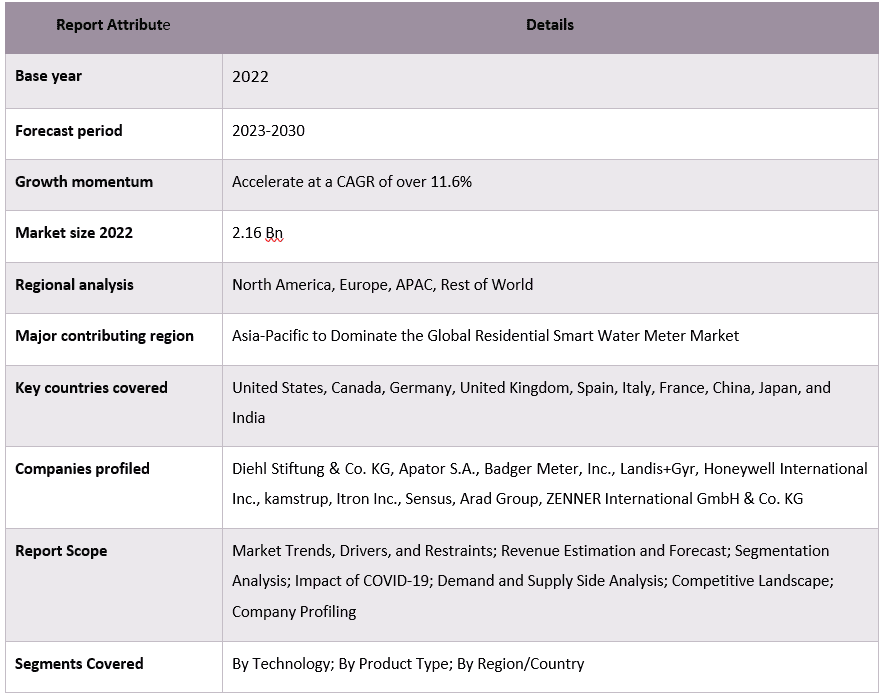
„Der asiatisch-pazifische Raum wird einen bedeutenden Anteil am Markt halten.“
Der intelligente Wasserzähler im Wohnbereich hat auch in der Region Asien-Pazifik eine bedeutende Präsenz erlangt. Faktoren wie die verstärkte Einführung intelligenter Technologien zur Reduzierung von Wasserknappheit und Utility-Non-Revenues in Verbindung mit günstigen staatlichen Vorschriften zur Einführung effizienter intelligenter Wasserzähler und zur Aufrechterhaltung einer effektiven Versorgung beschleunigen die Marktgröße des Marktes für intelligente Wasserzähler im Wohnbereich. Darüber hinaus installieren die Länder der Region intelligente Wasserzähler im Rahmen des Smart Water Meter Program, das darauf abzielt, Wasser in Haushalten zu sparen. Zum Beispiel: Im November 2022 arbeitete Singapurs nationale Wasserbehörde mit dem Itron Industrial IoT Network Canopy für intelligente Wasserzähler von SP Group, einer Versorgungsgruppe im asiatisch-pazifischen Raum, zusammen, um rund 300.000 intelligente Wasserzähler für Wohngebäude und C&I anzuschließen und die Ziele der Wassereinsparung voranzutreiben.
F1: Wie groß ist die aktuelle Marktgröße und das Wachstumspotenzial des globalen Marktes für intelligente Wasserzähler im Wohnbereich?
Antwort: Der globale Markt für intelligente Wasserzähler im Wohnbereich wurde im Jahr 2022 auf 2,16 Milliarden US-Dollar geschätzt und wird voraussichtlich im Prognosezeitraum (2023-2030) mit einer durchschnittlichen jährlichen Wachstumsrate von 11,6 % wachsen.
F2: Was sind die treibenden Faktoren für das Wachstum des globalen Marktes für intelligente Wasserzähler im Wohnbereich?
Antwort: Zunehmende Wasserleckagen und wachsendes Bewusstsein für Wassereinsparung
F3: Welches Segment hat den größten Anteil am globalen Markt für intelligente Wasserzähler im Wohnbereich nach Technologie?
Antwort: Das Segment der fortschrittlichen Messinfrastruktur (AMI) verzeichnete im Jahr 2022 einen bedeutenden Marktanteil.
F4: Was sind die aufkommenden Technologien und Trends auf dem globalen Markt für intelligente Wasserzähler im Wohnbereich?
Antwort: Zunehmende Akzeptanz von Smart-Home-Technologien
F5: Welche Region wird den globalen Markt für intelligente Wasserzähler im Wohnbereich dominieren?
Antwort: Es wird erwartet, dass Nordamerika den Markt im Prognosezeitraum dominieren wird.
F6: Wer sind die wichtigsten Akteure auf dem globalen Markt für intelligente Wasserzähler im Wohnbereich?
Antwort: Diehl Stiftung & Co. KG, Apator S.A., Badger Meter, Inc., Landis+Gyr, Honeywell International Inc., kamstrup, Itron Inc., Sensus, Arad Group, ZENNER International GmbH & Co. KG
Gründe für den Kauf dieses Berichts:
- Die Studie umfasst Marktgrößen- und Prognoseanalysen, die von authentifizierten wichtigen Branchenexperten validiert wurden.
- Der Bericht bietet einen schnellen Überblick über die Gesamtleistung der Branche auf einen Blick.
- Der Bericht behandelt eine eingehende Analyse der wichtigsten Branchenkollegen mit einem primären Fokus auf wichtige Geschäftskennzahlen, das Produktportfolio, Expansionsstrategien und die jüngsten Entwicklungen.
- Detaillierte Untersuchung der treibenden Kräfte, Beschränkungen, wichtigsten Trends und Chancen, die in der Branche vorherrschen.
- Die Studie deckt den Markt umfassend über verschiedene Segmente hinweg ab.
- Tiefgreifende regionale Analyse der Branche.
Anpassungsoptionen:
Der globale Markt für intelligente Wasserzähler im Wohnbereich kann je nach Anforderung oder anderem Marktsegment weiter angepasst werden. Darüber hinaus versteht UMI, dass Sie möglicherweise Ihre eigenen geschäftlichen Anforderungen haben. Nehmen Sie daher Kontakt mit uns auf, um einen Bericht zu erhalten, der Ihren Anforderungen vollständig entspricht.
Inhaltsverzeichnis
ForschungsMethodik für die Marktanalyse für intelligente Wasserzähler im Wohnbereich (2023-2030)
Die Analyse des historischen Marktes, die Schätzung des aktuellen Marktes und die Prognose des zukünftigen Marktes des globalen Marktes für intelligente Wasserzähler im Wohnbereich waren die drei wichtigsten Schritte, die unternommen wurden, um die Einführung von intelligenten Wasserzählern im Wohnbereich in wichtigen Regionen weltweit zu erstellen und zu analysieren. Es wurden umfassende Sekundärrecherchen durchgeführt, um die historischen Marktzahlen zu erfassen und die aktuelle Marktgröße zu schätzen. Zweitens wurden zahlreiche Erkenntnisse und Annahmen berücksichtigt, um diese Erkenntnisse zu validieren. Darüber hinaus wurden umfassende Primärinterviews mit Branchenexperten entlang der Wertschöpfungskette des globalen Marktes für intelligente Wasserzähler im Wohnbereich geführt. Nach der Annahme und Validierung der Marktzahlen durch Primärinterviews wendeten wir einen Top-Down/Bottom-Up-Ansatz an, um die vollständige Marktgröße zu prognostizieren. Danach wurden Methoden zur Aufschlüsselung des Marktes und zur Datentriangulation angewendet, um die Marktgröße von Segmenten und Subsegmenten der betreffenden Branche zu schätzen und zu analysieren. Die detaillierte Methodik wird im Folgenden erläutert:
Analyse der historischen Marktgröße
Schritt 1: Eingehende Untersuchung sekundärer Quellen:
Es wurde eine detaillierte Sekundärstudie durchgeführt, um die historische Marktgröße des Marktes für intelligente Wasserzähler im Wohnbereich über unternehmensinterne Quellen wie Geschäftsberichte und Finanzberichte, Performance-Präsentationen, Pressemitteilungen usw. und externe Quellen wie Fachzeitschriften, Nachrichten und Artikel, Regierungsveröffentlichungen, Wettbewerberpublikationen, Sektorberichte, Datenbanken von Drittanbietern und andere glaubwürdige Publikationen zu erhalten.
Schritt 2: Marktsegmentierung:
Nachdem wir die historische Marktgröße des Marktes für intelligente Wasserzähler im Wohnbereich erhalten hatten, führten wir eine detaillierte Sekundäranalyse durch, um historische Markteinblicke und Anteile für verschiedene Segmente und Subsegmente für wichtige Regionen zu sammeln. Die wichtigsten im Bericht enthaltenen Segmente sind Technologie und Produkttyp. Darüber hinaus wurden Analysen auf Länderebene durchgeführt, um die allgemeine Einführung von Testmodellen in dieser Region zu bewerten.
Schritt 3: Faktorenanalyse:
Nachdem wir die historische Marktgröße verschiedener Segmente und Subsegmente ermittelt hatten, führten wir eine detaillierte Faktorenanalyse durch, um die aktuelle Marktgröße des Marktes für intelligente Wasserzähler im Wohnbereich zu schätzen. Darüber hinaus führten wir eine Faktorenanalyse unter Verwendung abhängiger und unabhängiger Variablen wie verschiedener Technologien und Produkttypen von intelligenten Wasserzählern im Wohnbereich durch. Es wurde eine gründliche Analyse für Nachfrage- und Angebotsseitenszenarien unter Berücksichtigung von Top-Partnerschaften, Fusionen und Übernahmen, Geschäftsausweitungen und Produkteinführungen im Bereich der intelligenten Wasserzähler im Wohnbereich weltweit durchgeführt.
Aktuelle Marktgrößenschätzung & Prognose
Aktuelle Marktgrößenbestimmung: Basierend auf verwertbaren Erkenntnissen aus den oben genannten 3 Schritten ermittelten wir die aktuelle Marktgröße, die wichtigsten Akteure auf dem globalen Markt für intelligente Wasserzähler im Wohnbereich und die Marktanteile der Segmente. Alle erforderlichen prozentualen Anteile, Aufteilungen und Marktaufschlüsselungen wurden mithilfe des oben genannten sekundären Ansatzes ermittelt und durch Primärinterviews verifiziert.
Schätzung & Prognose: Für die Marktschätzung und -prognose wurden verschiedenen Faktoren Gewichte zugewiesen, darunter Treiber & Trends, Einschränkungen und Chancen, die den Stakeholdern zur Verfügung stehen. Nach der Analyse dieser Faktoren wurden relevante Prognosetechniken, d. h. der Top-Down/Bottom-Up-Ansatz, angewendet, um die Marktprognose für 2028 für verschiedene Segmente und Subsegmente in den wichtigsten Märkten weltweit zu erstellen. Die Forschungsmethodik zur Schätzung der Marktgröße umfasst:
- Die Marktgröße der Branche in Bezug auf den Umsatz (USD) und die Akzeptanzrate des Marktes für intelligente Wasserzähler im Wohnbereich in den wichtigsten Märkten im Inland
- Alle prozentualen Anteile, Aufteilungen und Aufschlüsselungen von Marktsegmenten und Subsegmenten
- Wichtige Akteure auf dem globalen Markt für intelligente Wasserzähler im Wohnbereich in Bezug auf die angebotenen Produkte. Auch die von diesen Akteuren angewandten Wachstumsstrategien, um im schnell wachsenden Markt zu konkurrieren.
Validierung der Marktgröße und des Marktanteils
Primärforschung: Es wurden ausführliche Interviews mit den Key Opinion Leaders (KOLs) geführt, darunter Führungskräfte der obersten Ebene (CXO/VPs, Vertriebsleiter, Marketingleiter, Betriebsleiter, Regionalleiter, Landesleiter usw.) in wichtigen Regionen. Die Ergebnisse der Primärforschung wurden dann zusammengefasst und eine statistische Analyse durchgeführt, um die aufgestellte Hypothese zu beweisen. Die Erkenntnisse aus der Primärforschung wurden mit den Ergebnissen der Sekundärforschung zusammengeführt, wodurch Informationen in verwertbare Erkenntnisse umgewandelt wurden.
Aufteilung der Primärteilnehmer in verschiedenen Regionen
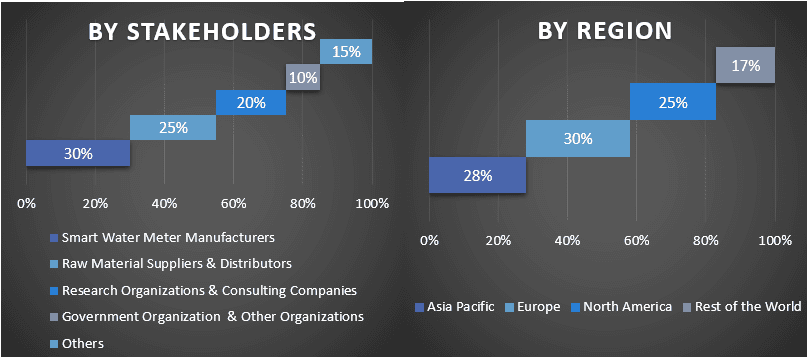
Markt Engineering
Die Datentriangulationstechnik wurde angewendet, um die Gesamtmarktschätzung abzuschließen und präzise statistische Zahlen für jedes Segment und Subsegment des globalen Marktes für intelligente Wasserzähler im Wohnbereich zu erhalten. Die Daten wurden nach dem Studium verschiedener Parameter und Trends in den Bereichen Technologie und Produkttyp im globalen Markt für intelligente Wasserzähler im Wohnbereich in mehrere Segmente und Subsegmente aufgeteilt.
Das Hauptziel der globalen Marktstudie für intelligente Wasserzähler im Wohnbereich
Die aktuellen und zukünftigen Markttrends des globalen Marktes für intelligente Wasserzähler im Wohnbereich wurden in der Studie genau bestimmt. Investoren können strategische Einblicke gewinnen, um ihre Entscheidungen für Investitionen auf der Grundlage der in der Studie durchgeführten qualitativen und quantitativen Analyse zu treffen. Aktuelle und zukünftige Markttrends bestimmten die Gesamtattraktivität des Marktes auf regionaler Ebene und bieten den Industrieteilnehmern eine Plattform, um den unerschlossenen Markt zu nutzen, um von einem First-Mover-Vorteil zu profitieren. Weitere quantitative Ziele der Studien sind:
- Analyse der aktuellen und prognostizierten Marktgröße des Marktes für intelligente Wasserzähler im Wohnbereich in Bezug auf den Wert (USD). Analysieren Sie auch die aktuelle und prognostizierte Marktgröße verschiedener Segmente und Subsegmente.
- Segmente in der Studie umfassen Bereiche der Technologie und des Produkttyps.
- Definition und Analyse des regulatorischen Rahmens für den intelligenten Wasserzähler im Wohnbereich
- Analyse der Wertschöpfungskette unter Einbeziehung verschiedener Intermediäre sowie Analyse des Kunden- und Wettbewerberverhaltens der Branche.
- Analyse der aktuellen und prognostizierten Marktgröße des Marktes für intelligente Wasserzähler im Wohnbereich für die wichtigsten Regionen.
- Zu den wichtigsten Ländern der in dem Bericht untersuchten Regionen gehören der asiatisch-pazifische Raum, Europa, Nordamerika und der Rest der Welt.
- Unternehmensprofile des Marktes für intelligente Wasserzähler im Wohnbereich und die von den Marktteilnehmern angewandten Wachstumsstrategien, um sich in dem schnell wachsenden Markt zu behaupten.
Eingehende regionale Analyse der Branche
Verwandt Berichte
Kunden, die diesen Artikel gekauft haben, kauften auch

